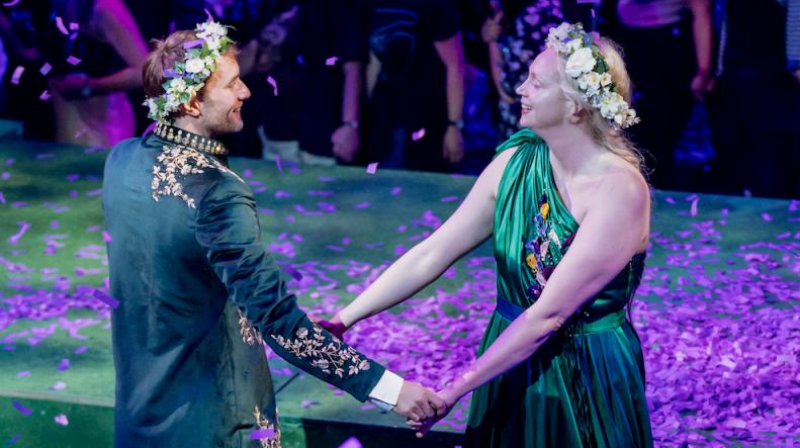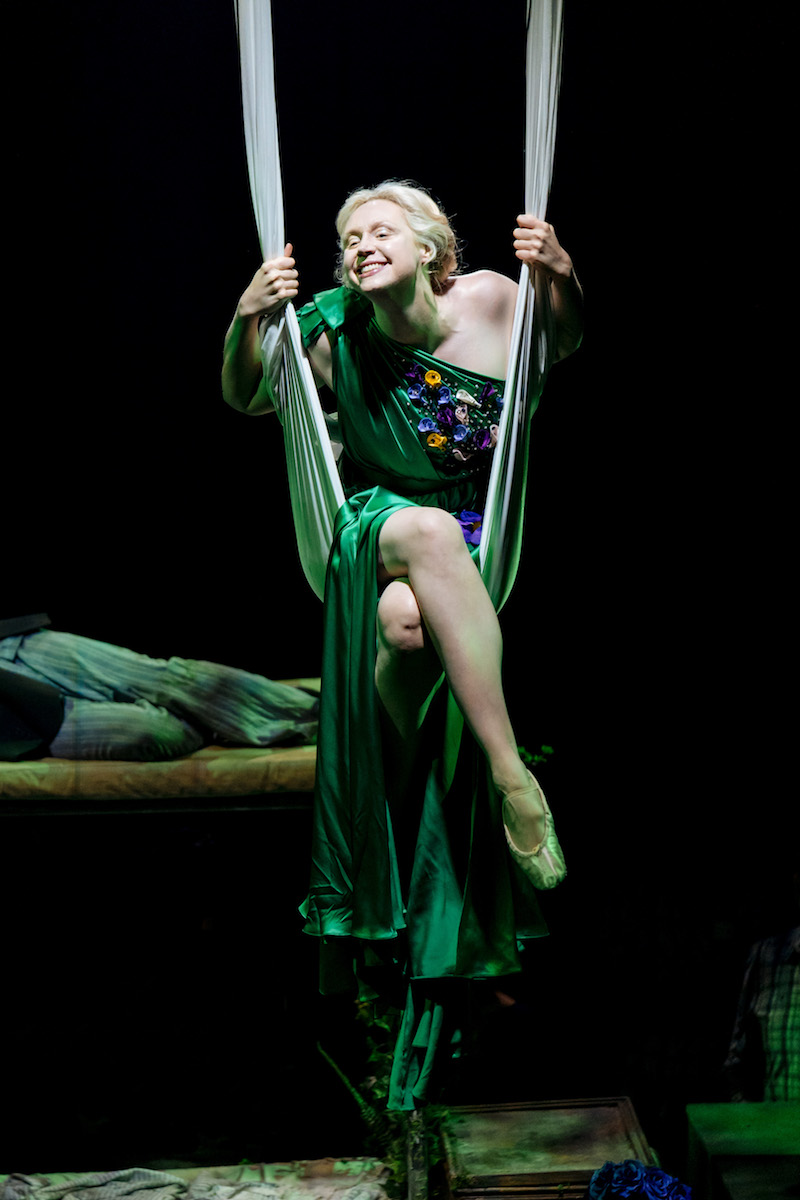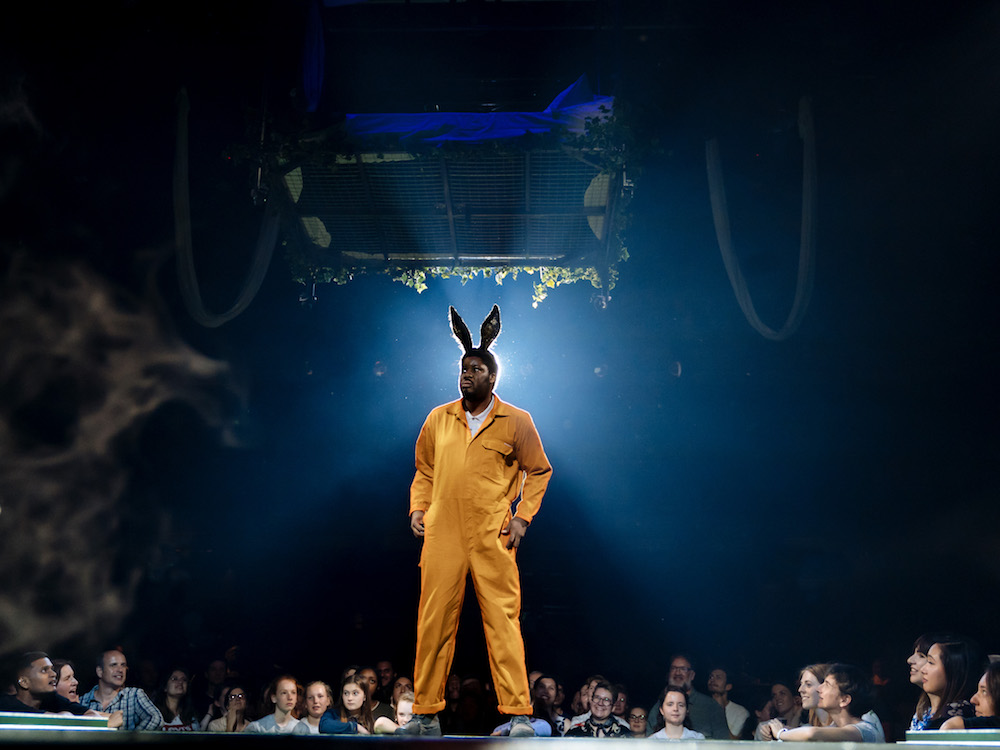A Midsummer Night's Dream, National Theatre At Home review – a mad delight | reviews, news & interviews
A Midsummer Night's Dream, National Theatre At Home review – a mad delight
A Midsummer Night's Dream, National Theatre At Home review – a mad delight
Nicholas Hytner makes the familiar gloriously strange in this slippery, sumptuous show

Nicholas Hytner’s A Midsummer Night’s Dream, filmed for NT Live at the Bridge Theatre last summer, is – as it gleefully acknowledges – completely bonkers. But it doesn’t start out that way.
 It’s a testament to Hytner’s skill that he’s able to balance dream and reality so well. His trick is to switch up Titania (Gwendoline Christie, pictured right) and Oberon’s (Oliver Chris) lines: here, it’s the fairy king who falls in love with an ass-headed mortal, the queen who manipulates him via Puck (a genuinely otherworldly David Moorst). But Oberon and Bottom’s (Hammed Animashaun) relationship isn’t the butt of the joke. Everything is imbued with such warmth and fondness that it’s like the show is laughing with the audience every step of the way. NT Live can’t recreate the experience of being in the crowd, but you can still feel the sheer delight of this production. “Plays are boring!” Puck whines when he comes across the Rude Mechanicals. Not this one, Robin.
It’s a testament to Hytner’s skill that he’s able to balance dream and reality so well. His trick is to switch up Titania (Gwendoline Christie, pictured right) and Oberon’s (Oliver Chris) lines: here, it’s the fairy king who falls in love with an ass-headed mortal, the queen who manipulates him via Puck (a genuinely otherworldly David Moorst). But Oberon and Bottom’s (Hammed Animashaun) relationship isn’t the butt of the joke. Everything is imbued with such warmth and fondness that it’s like the show is laughing with the audience every step of the way. NT Live can’t recreate the experience of being in the crowd, but you can still feel the sheer delight of this production. “Plays are boring!” Puck whines when he comes across the Rude Mechanicals. Not this one, Robin.
The versatility of Bunny Christie’s set suits the play’s shifting ground perfectly. Characters disappear into the audience and pop up in unexpected places. The audience disappears and pops up in unexpected places – kudos to the stage crew for what’s essentially an extended exercise in crowd control. This is a play that reminds us of the word’s roots: a light-footed, dancing thing, as graceful as the fairies spinning on their aerial silks (inspired by Peter Brook’s 1970 production for the RSC). Moorst had only had three months’ training before rehearsals started, but just watching him swoop and tumble is enough to make your feet cramp.
Animashaun (pictured below), along with Kit Young (a superbly angsty Lysander) and Isis Hainsworth (an all-guns-blazing Hermia), was nominated for the Ian Charleson Award for his performance, with good reason: it’s like Bottom was written for him. He’s witty, coy, sweet, and vulnerable, sometimes all in a matter of seconds. He can do things with his eyes that most actors can’t do with their whole bodies. And he makes full use of Hytner’s penchant for weaving extra lines seamlessly into the text, bringing Shakespeare just that little bit closer to today. As does the Titania-Oberon switch, of course. Sexualities and gender presentations are slipped on and off as smoothly as Oberon’s gorgeous golden robe (costumes by Christina Cunningham), all to a sumptuous soundtrack of Beyoncé and Florence and the Machine.

The play escapes a tragic ending by the skin of its teeth, thanks to Titania/Hippolyta. As with all good adaptations, it’s difficult to see how it could have been any other way. Of course it makes more sense for Titania to run fairy rings around Oberon, and for her gentle reminder of his affair with Bottom to nudge him into a more lenient attitude towards the lovers. Who would deny the magnificent Christie all the power she wants? Even shut up in a glass box like she’s on Naked Attraction, she’s more prowling tiger than caged bird. She and Chris are brilliant together, all the more so when he’s struck by a beautifully-timed attack of the giggles. That it doesn’t kill the mood illustrates perfectly the calibre of spell the show has cast.
A Midsummer Night’s Dream has a vaguely apocalyptic air about it – there’s a sense that a danger more threatening than the fairies’ harmless mischief is lurking just underneath the surface. But this show is still the perfect escape back into a world where people moved through thronged crowds and clasped strangers’ hands unthinkingly.
The future of Arts Journalism
You can stop theartsdesk.com closing!
We urgently need financing to survive. Our fundraising drive has thus far raised £49,000 but we need to reach £100,000 or we will be forced to close. Please contribute here: https://gofund.me/c3f6033d
And if you can forward this information to anyone who might assist, we’d be grateful.

Subscribe to theartsdesk.com
Thank you for continuing to read our work on theartsdesk.com. For unlimited access to every article in its entirety, including our archive of more than 15,000 pieces, we're asking for £5 per month or £40 per year. We feel it's a very good deal, and hope you do too.
To take a subscription now simply click here.
And if you're looking for that extra gift for a friend or family member, why not treat them to a theartsdesk.com gift subscription?
more Theatre
 Top Hat, Chichester Festival Theatre review - top spectacle but book tails off
Glitz and glamour in revived dance show based on Fred and Ginger's movie
Top Hat, Chichester Festival Theatre review - top spectacle but book tails off
Glitz and glamour in revived dance show based on Fred and Ginger's movie
 Edinburgh Fringe 2025 reviews: Alright Sunshine / K Mak at the Planetarium / PAINKILLERS
Three early Fringe theatre shows offer blissed-out beats, identity questions and powerful drama
Edinburgh Fringe 2025 reviews: Alright Sunshine / K Mak at the Planetarium / PAINKILLERS
Three early Fringe theatre shows offer blissed-out beats, identity questions and powerful drama
 The Daughter of Time, Charing Cross Theatre review - unfocused version of novel that cleared Richard III
The writer did impressive research but shouldn't have fleshed out Josephine Tey’s story
The Daughter of Time, Charing Cross Theatre review - unfocused version of novel that cleared Richard III
The writer did impressive research but shouldn't have fleshed out Josephine Tey’s story
 Evita, London Palladium review - even more thrilling the second time round
Andrew Lloyd Webber's best musical gets a brave, biting makeover for the modern age
Evita, London Palladium review - even more thrilling the second time round
Andrew Lloyd Webber's best musical gets a brave, biting makeover for the modern age
 Maiden Voyage, Southwark Playhouse review - new musical runs aground
Pleasant tunes well sung and a good story, but not a good show
Maiden Voyage, Southwark Playhouse review - new musical runs aground
Pleasant tunes well sung and a good story, but not a good show
 The Winter's Tale, RSC, Stratford review - problem play proves problematic
Strong women have the last laugh, but the play's bizarre structure overwhelms everything
The Winter's Tale, RSC, Stratford review - problem play proves problematic
Strong women have the last laugh, but the play's bizarre structure overwhelms everything
 Brixton Calling, Southwark Playhouse review - life-affirming entertainment, both then and now
Nostalgic, but the message is bang up to date
Brixton Calling, Southwark Playhouse review - life-affirming entertainment, both then and now
Nostalgic, but the message is bang up to date
 Inter Alia, National Theatre review - dazzling performance, questionable writing
Suzie Miller’s follow up to her massive hit 'Prima Facie' stars Rosamund Pike
Inter Alia, National Theatre review - dazzling performance, questionable writing
Suzie Miller’s follow up to her massive hit 'Prima Facie' stars Rosamund Pike
 A Moon for the Misbegotten, Almeida Theatre review - Michael Shannon sears the night sky
Rebecca Frecknall shifts American gears to largely satisfying effect
A Moon for the Misbegotten, Almeida Theatre review - Michael Shannon sears the night sky
Rebecca Frecknall shifts American gears to largely satisfying effect
 Burlesque, Savoy Theatre review - exhaustingly vapid
Adaptation of 2010 film is busy, bustling - and bad
Burlesque, Savoy Theatre review - exhaustingly vapid
Adaptation of 2010 film is busy, bustling - and bad
 Don't Rock the Boat, The Mill at Sonning review - all aboard for some old-school comedy mishaps
Great fun, if more 20th century than 21st
Don't Rock the Boat, The Mill at Sonning review - all aboard for some old-school comedy mishaps
Great fun, if more 20th century than 21st
 The Estate, National Theatre review - hugely entertaining, but also unconvincing
Comedy debut stars Adeel Akhtar, but is an awkward mix of the personal and the political
The Estate, National Theatre review - hugely entertaining, but also unconvincing
Comedy debut stars Adeel Akhtar, but is an awkward mix of the personal and the political

Add comment